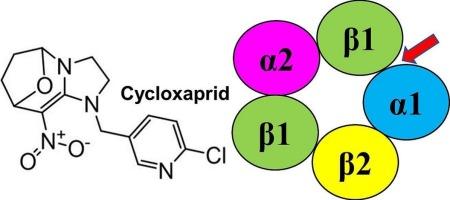Target identification and mechanism of action of the neonicotinoid Cycloxaprid
IF 4
1区 农林科学
Q2 BIOCHEMISTRY & MOLECULAR BIOLOGY
引用次数: 0
Abstract
Neonicotinoid insecticides targeting nicotinic acetylcholine receptors (nAChRs) are critical for agricultural pest control but face challenges from rapid resistance and environmental toxicity. Cycloxaprid, a cis-nitro-configured neonicotinoid analog, shows unique pharmacological properties that may circumvent cross-resistance. Here, we elucidated its mode of action in Drosophila melanogaster through integrated genetic, electrophysiological, and computational approaches. Cycloxaprid induced excitatory neurotoxicity, including hyperactivity, uncoordinated locomotion, and tremors, consistent with nAChR overactivation. Bioassays with Drosophila nAChR subunit mutants demonstrated that the α1, α2, β1, and β2 subunits are essential for insecticidal activity. Heterologous expression of the α1α2β1β2 nAChR in Xenopus oocytes revealed cycloxaprid acts as a partial agonist (EC50 = 34.7 nM; 37.7 % maximal acetylcholine response) and enhances acetylcholine-evoked currents at sub-saturating doses. AI-driven structural modeling (Chai-1) localized cycloxaprid within the canonical agonist-binding site at the α1–β1 interface, forming key electrostatic interactions with residues like Arg81 in the β1 subunit. Collectively, these results elucidate the molecular basis of cycloxaprid's insecticidal activity and underscore its potential as a valuable tool for resistance management.

新烟碱类环磷酰胺的靶点鉴定及作用机理
以烟碱乙酰胆碱受体(nAChRs)为靶点的新烟碱类杀虫剂在农业害虫防治中具有重要意义,但面临着快速抗性和环境毒性的挑战。环xaprid是一种顺式硝基结构的新烟碱类似物,具有独特的药理学性质,可以规避交叉抗性。在这里,我们通过综合遗传学、电生理学和计算方法阐明了它在黑腹果蝇中的作用模式。环xaprid诱导兴奋性神经毒性,包括多动症、不协调运动和震颤,与nAChR过度激活一致。对果蝇nAChR亚基突变体的生物测定表明,α1、α2、β1和β2亚基对杀虫活性至关重要。α1α2β1β2 nAChR在爪蟾卵母细胞中的异源表达表明,环xaprid可作为部分激动剂(EC50 = 34.7 nM;最大乙酰胆碱反应37.7%),并在亚饱和剂量下增强乙酰胆碱诱发电流。ai驱动的结构模型(cai -1)将环xaprid定位在α1 -β1界面的典型激动剂结合位点,与β1亚基中的Arg81等残基形成关键的静电相互作用。总的来说,这些结果阐明了环xaprid杀虫活性的分子基础,并强调了其作为抗性管理的有价值工具的潜力。
本文章由计算机程序翻译,如有差异,请以英文原文为准。
求助全文
约1分钟内获得全文
求助全文
来源期刊
CiteScore
7.00
自引率
8.50%
发文量
238
审稿时长
4.2 months
期刊介绍:
Pesticide Biochemistry and Physiology publishes original scientific articles pertaining to the mode of action of plant protection agents such as insecticides, fungicides, herbicides, and similar compounds, including nonlethal pest control agents, biosynthesis of pheromones, hormones, and plant resistance agents. Manuscripts may include a biochemical, physiological, or molecular study for an understanding of comparative toxicology or selective toxicity of both target and nontarget organisms. Particular interest will be given to studies on the molecular biology of pest control, toxicology, and pesticide resistance.
Research Areas Emphasized Include the Biochemistry and Physiology of:
• Comparative toxicity
• Mode of action
• Pathophysiology
• Plant growth regulators
• Resistance
• Other effects of pesticides on both parasites and hosts.

 求助内容:
求助内容: 应助结果提醒方式:
应助结果提醒方式:


